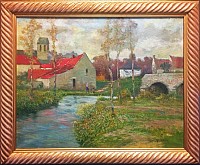BIOGRAPHY

George Ames Aldrich (American 1872-1941)
One of South Bend, Indiana's best-known landscape painters of the 20th century, George Ames Aldrich became most associated with richly painted impressionist landscapes with water of Brittany and Normandy.
He was born in Worcester, Massachusetts on June 3, 1872. His early art experience took place in the 1890's while living in Europe. He studied art in the Midwest, the East Coast, and throughout Europe, becoming a successful and respected etcher and painter. He worked as an illustrator for both Punch magazine and The London Times in the 1890's.
Returning to the United States, he became a member of the Art Students' League in New York City. Soon thereafter, it is thought he may have studied architecture at M.I.T. in Massachusetts, and his experience there is evident in the buildings and houses in many of his landscapes.
Aldrich continued his art education in Paris, attending Academies Julian and Colarossi, and later joining the Societe des Artistes Francais. His personal style was refined as he spent several years traveling throughout Europe. Between 1909 and 1910, Aldrich lived with artist/instructor Dieppe, completing many of his most popular paintings in Normandy and Brittany.
In 1918, Aldrich arrived in Chicago and became involved with the South Bend art scene during the 1920s. The Indiana dune country, at the southern end of Lake Michigan, was a popular subject for Chicago's painters. The area had reverted to wilderness after the Indians left and after the Chicago fire, when thousands of trees were cut down to rebuild the city.
Aldrich exhibited regularly at the Art Institute of Chicago, and was a member of the Chicago Galleries Association, the Hoosier Salon, and the Chicago Society of Painters and Sculptors. In 1924, he won an architectural club traveling scholarship and traveled to Europe to paint in England, Germany, Spain, Italy, and France.
His work is represented in many museums throughout the world, and many private and corporate collections carry his work including the Union League of Chicago and the War Mothers Building in Washington DC.
